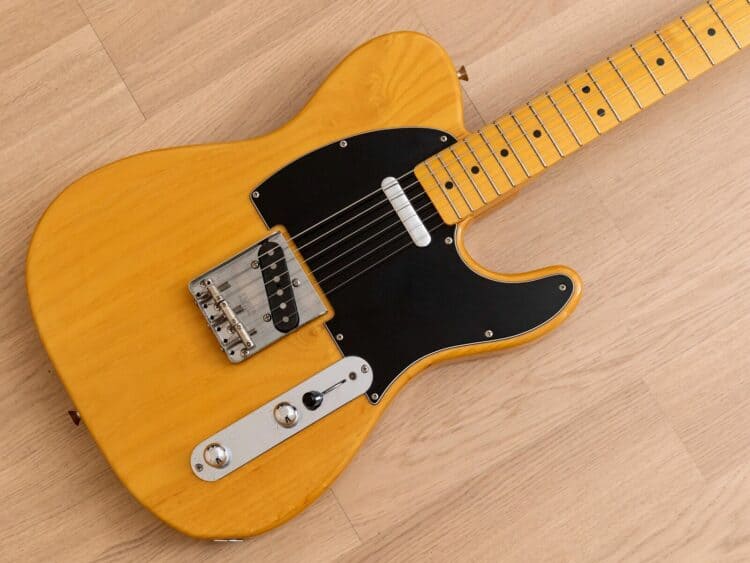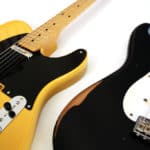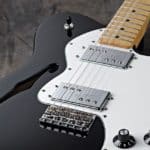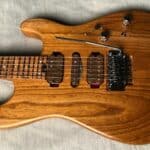The Telecaster, at this point, is a part of modern culture.
Through the years the model has become just a type of guitar that many different brands replicate in their own way.
Naturally, one of the many variations possible on the original design is using different materials that imprint a different personality in the instrument.
But after all these variations, what is the best wood for a Telecaster?
Original Telecasters were made of alder or swamp ash and maple. These materials were selected because of their availability and quality in the early ’50s. Nowadays, it’s harder to find high-quality specimens of these woods, so manufacturers gravitate to alternative ones such as basswood or poplar.
In this article, I will discuss everything there is about the different tonewoods used in telecasters through the years, and why manufacturers might choose one over the others.
After leaving this page, you will have a clear idea about what materials work well for a Tele, and why builders tend to have gravitated to a particular set of them over the last decades.
Are you ready to get started?
Let’s go!
What makes for a great tonewood
Although tonewoods are debated among guitar players, especially for electric guitars, I’m a big proponent that they actually do make a difference.
However, we are not here to discuss that now.
Assuming that tonewoods are important for a guitar, it’s only natural to also accept that there might be different “qualities” of them in the wild.
And, although this quality I mention can be used to rank specific types of wood, or species (or anyway it should be said) such as Alder, Swamp Ash, Maple, Cedar, Rosewood, etc. or their different local variants (Indian rosewood, Brazilian rosewood) I also think about it within slabs of the same kind.
You see, you can find two pieces of comparable trees of Alder, however, one has been cut very recently and the other one was stored for 70 years.
In this case, you can expect that the older exemplar will probably be way better “stationed”, dryer, and more resonant for the use on a guitar.
This is a big tradeoff a lot of manufacturers have to think about nowadays with the current availability of woods, but I will touch on this later.
Legendary Teles were built with alder, swamp ash, and maple
When the Telecaster (or, or Broadcaster, or actually the Esquire) was prototyped and then entered production in the early 50s Leo Fender built it with was reasonable.
And I highlight “reasonable” because it’s evident that there was not much thought put into how the materials would interact with each other, or what would look better on a guitar.
Fender just used what was available and what worked in terms of costs and acceptable quality.
Decades later, and after the Tele had been used in thousands of legendary songs, and its sound is engraved in our brains, now the resulting tone from using materials probably picked due to their affordability is very sought-after.
The thing is, and as I will discuss later, that these materials (alder, swamp ash, and maple) are not available in the same qualities as they were back in the fifties.
So now, there’s a tradeoff between material authenticity and tonewood quality when building a modern Tele.
Other alternatives
Given the simplicity of the Telecaster, builders that took on the model tried just about anything with it.
From mahogany to korina to basswood to even rosewood or poplar on more affordable models. Anything could work on a Tele, and give it a slightly different character.
Traditional Telecaster tonewoods, especially for the body, tend to be rather neutral, so going for a hardwood might bring out a bit more depth to the instrument.
However, you can’t go wrong with any good quality tonewood when building a Telecaster. It will be just a matter of liking that particular taste.
Quality vs availability
As I mentioned earlier, these days, with mass production in mind, manufacturers and artisans have to deal with a ubiquitous tradeoff between quality and availability.
Making a guitar with its vintage old specs it’s not economically possible in many cases, and in some others, not even legal.
From finishes to certain protected kinds of woods, manufacturers have to make compromises to deliver goods at a payable price point.
Alder, for instance, is a type of wood in high demand, and its production can’t keep up with the market needs.
Remember a tree can take about 20 years to be ready for processing.
This only causes available stocks to be young and not really well-fitted for guitar making.
A completely different scenario from what Fender had to deal with in the early ‘50s when the Telecaster was first prototyped, and the woods they chose to make it were among the most affordable and easier to come by.
One could argue that if such a guitar was designed in the current times, its builders will probably gravitate to some alternative kind of wood that is currently commonly available in conditions suited for guitar-making, such as the ones mentioned above.
Conclusion
There is no best wood for a Telecaster since it mostly depends on the quality of the current slabs available. When the original runs were made, ash, alder, and maple were a great alternative, however, nowadays their quality is lacking. This is why manufacturers use substitute materials.

Hello there, my name is Ramiro and I’ve been playing guitar for almost 20 years. I’m obsessed with everything gear-related and I thought it might be worth sharing it. From guitars, pedals, amps, and synths to studio gear and production tips, I hope you find what I post here useful, and I’ll try my best to keep it entertaining also.





